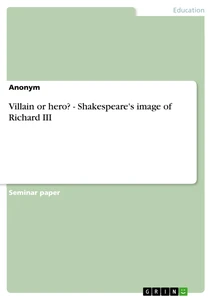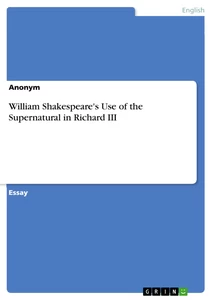First things first:
- The tragedy was probably written around 1593 by William Shakespeare
- The last of four plays, all of which deal with the reign of Henry VI of England and are set at the time of the War of the Roses
- The play was premiered in November 1633
Summary
“Richard III” tells the story of King Richard III’s rise and fall. The Wars of the Roses between the House of York and the House of Lancaster have ended, with York emerging victorious. King Edward IV rules alongside his brothers, George, Duke of Clarence, and Richard, Duke of Gloucester. But Richard has other plans and wants the throne for himself. With the help of his loyal ally Buckingham, he has his brother George killed, and his older brother Edward dies soon after. Edward’s son is too young to rule, so Richard steps in as regent.
Richard marries Lady Anne, whose husband he killed in battle, declares Edward’s sons illegitimate, and is crowned king. Quickly becoming bitter and power-mad, he orders the murder of his nephews in the Tower of London, his ally Buckingham, and even his wife Anne. To secure his claim, he plans to marry his niece Elizabeth.
Meanwhile, the last survivor of the Lancastrian line, Richmond, gathers forces to challenge Richard. The night before their battle, Richard is haunted by the ghosts of his victims. Weakened, he loses the battle and is killed by Richmond, who is crowned King Henry VII and marries Elizabeth, uniting the Houses of Lancaster and York and beginning the Tudor dynasty.
Main characters
Richard (Duke of Gloucester)
- physically deformed
- intelligent and charismatic
- Manipulative and mendacious
- brutal
More about Richard as the villain in Villain or hero? – Shakespeare’s image of Richard III:
Although most of the time the reliable sources revise their opinion about this monarch a few paragraphs later, the first impression on the history-interested person is made. The question here is what creates or created this image of the villainous and deformed Richard III? Some history books mention William Shakespeare’s history The Tragedy of King Richard III as one of the possible works that have been influencing the people’s opinions about this English king. This essay is intended to analyze in what way Shakespeare’s work undermines this thesis and what picture he really drew of the monarch Richard III.
George (Duke of Clarence)
- Richard’s older brother
- murdered in the Tower of London
Edward IV
- Richard’s eldest brother
- King and married to Elizabeth Woodville
- dies after an illness
- leaves behind two sons
Buckingham
- Richard’s loyal ally
- manipulative and cunning
- executed on Richard’s orders when he refuses to kill the princes
Richmond
- son of Henry VI
- House of Lancaster
- defeats and kills Richard in the final battle
- crowned king, and marries Edward IV’s daughter Elizabeth
- founder of the Tudor dynasty
Myth or reality?
Richard III of England was the last ruler of the House of Plantagenet. His death ended the Wars of the Roses. Thanks to Shakespeare’s play, Richard has a lasting negative reputation. But what really happened? What’s myth, and what’s reality?
Richard was born the youngest of eight sons, though only four survived. As a member of the 300-year ruling Plantagenet dynasty, his father had a legitimate claim to the English throne, which was held at the time by King Henry VI of the Lancastrian line, another branch of the Plantagenets. In 1461, Henry VI was overthrown, and Richard’s oldest brother Edward IV took power.
Unlike in the play, Richard was probably a loyal subject to his older brother. After Edward IV’s death, he supported his nephew and served as Lord Protector. Modern historians disagree on Richard’s shady reputation, which many attribute to unclear historical records from the Tudor era. It turns out he likely didn’t commit most of the crimes he’s accused of. It’s also still unknown if he was responsible for the deaths of his two nephews, the princes in the Tower.
The image of Richard as a cripple isn’t accurate either. Contemporary descriptions call him a slight man, and recent studies show he had scoliosis, not a deformity.
There’s no concrete evidence that Richard was the brutal and manipulative man the play portrays. We don’t know Shakespeare’s intentions for this depiction, but he lived and wrote during the reign of Elizabeth I—a Tudor. It’s possible he wrote this play as entertainment for the ruling family’s rivals.
Themes, motifs, and symbols
Richard’s appearance
Shakespeare’s “Richard III” is one of literature’s quintessential villains. Ruthless and without regard for family, he claws his way to the English throne. His deformity doesn’t seem to hold him back.
The Supernatural
Richard III includes supernatural elements like prophecies, ghosts, curses, and dreams.
The focus of the essay William Shakespeare’s Use of the Supernatural in Richard III lies in the investigation of three specific examples how William Shakespeare uses supernatural elements like dreams or ghosts in his historic play King Richard III, in order to learn how they influence the play structurally and psychologically.
Good to know/structure
- Shakespeare wrote the play early in his career, before he had much experience as a playwright.
- The play is classified under Elizabethan drama and breaks away from Aristotle’s theories of drama.
- Richard III is divided into five acts.
- The play is mostly written in blank verse and contains many antitheses.
Sources:
- Shakespeare, William. [c. 1597] 2009. King Richard III. Ed. Jamis Lull. Cambridge: Cambridge University Press.
- Richard III: Princes in the Tower. 2015. Dr. Ashley Gething. With Shaun Dooley, Tom Bacon, and James Gamon. Channel 4 Television. Video.
- Richard III: storyboardthat
Frequently asked questions
“Richard III” is about the power-hungry Richard, who kills his own family members to become King of England. In the end, he’s defeated and killed, marking the start of the Tudor dynasty.
Key themes include power, betrayal, revenge, and the supernatural. Shakespeare’s play explores how Richard gains power through schemes, and how his greed for the throne ultimately leads to his downfall.
Shakespeare’s Richard III is portrayed as a brutal and manipulative villain, but historical evidence suggests that many of the crimes attributed to him weren’t actually his doing.
Historians disagree about his true character. Shakespeare’s depiction as a ruthless villain may have been influenced by the political motives of the Tudor period, as the play was written during the reign of Elizabeth I, a Tudor.
You might also be interested in these articles:
Do you like our magazine?
Then sign up for our newsletter now!












